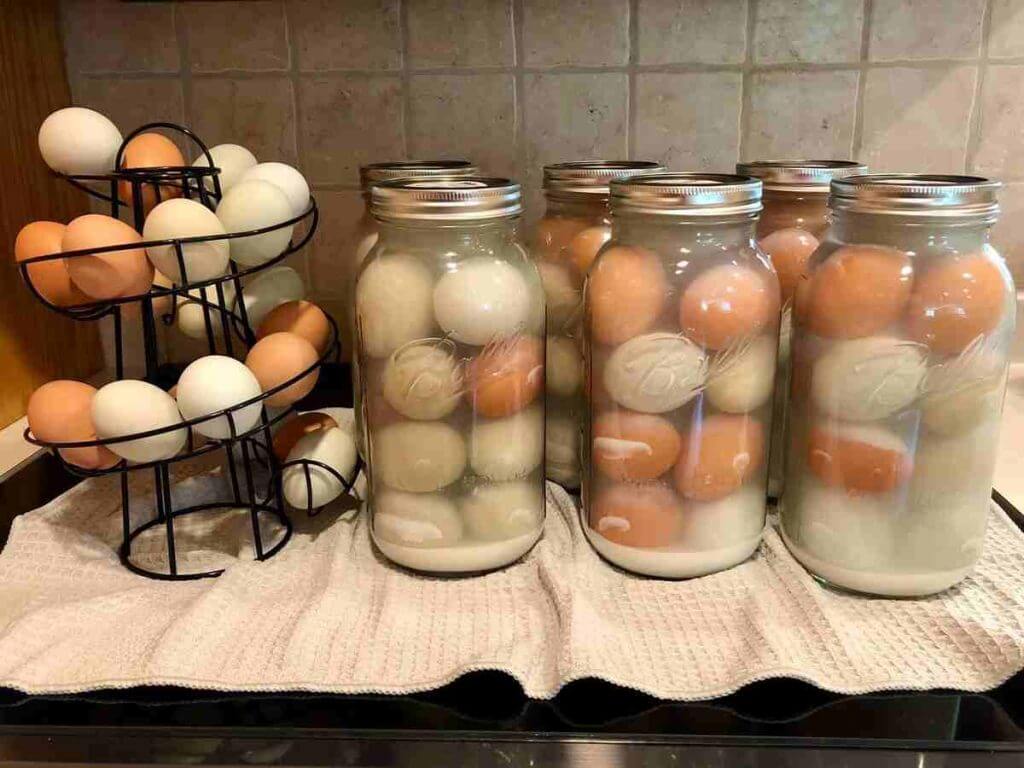
How To Preserve Eggs Using Water Glassing
Learn how to preserve eggs for long term use, using the age-old technique of water glassing.
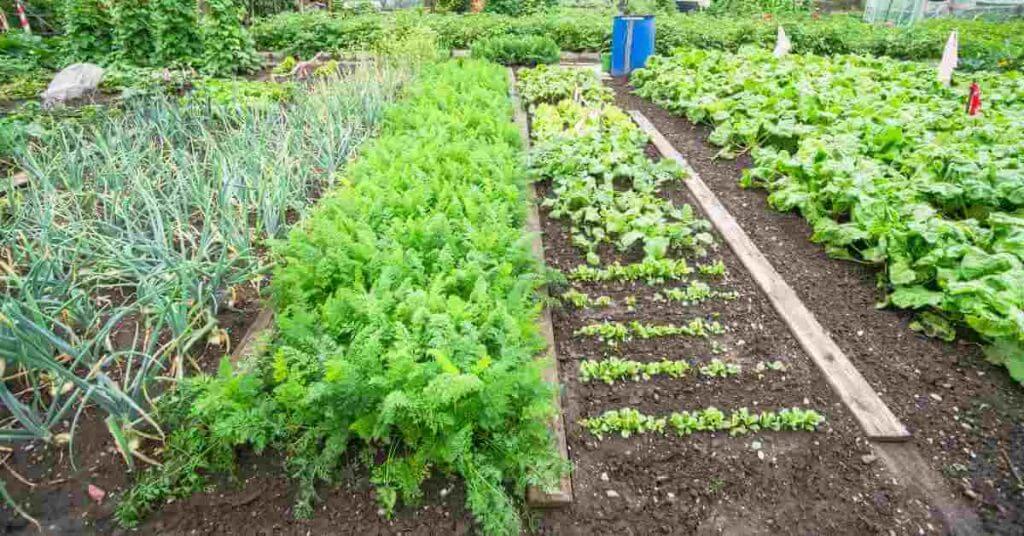
I was once asked what my number one tip for new gardeners is. My answer has always remained the same – keep it simple.
Welcome, then, to the world of no-dig gardening, where sustainability meets simplicity.
No-dig gardening does exactly what it says on the tin – it’s a method of growing plants that minimizes soil disturbance using simple but clever techniques. By avoiding soil disruption, we keep the many organisms and microbes in the soil thriving, all of which contribute to making your plants tastier and healthier while requiring minimal maintenance.
In this comprehensive guide, suitable for beginners and intermediate gardeners alike, we will explore the foundational principles that make no-dig gardening effective yet simple.
The benefits of no-dig gardening are vast; not only does it nurture the earth beneath our feet, but also fosters a symbiotic relationship with the environment, leading to enhanced soil health and, consequently, healthier plant life.
With knowledge in tow, we will then walk through a simple yet detailed 5-step process for you to build your own no-dig garden from scratch.
Whether a novice seeking a low-maintenance gardening method or a seasoned green thumb looking to adopt more eco-friendly practices, this guide is your gateway to a lush, flourishing garden that harmonizes with nature’s rhythms.
Put simply, no-dig gardening is a low-maintenance and sustainable method of gardening that focuses on minimizing soil disturbance, thereby promoting a microbe-rich soil that benefits growing plants.
Although similar “no-till” methods of cultivation have been around for centuries, the popularity of no-dig gardening soared from English gardener Charles Dowding’s impressive track record of growing fantastic vegetables using no-dig techniques.
The core focus behind no-dig gardening is enhancing the soil quality, specifically the preservation of microbes and organisms that work out of sight in your soil, all of which are impacted by breaking the soil when tilling, turning, or using chemicals.
No-dig techniques can make it tricky to deal with weeds, which root below the surface. Thankfully, Charles Dowding has come up with an ingenious way of using layered cardboard to suffocate the weeds of sunlight, killing them outright. The cardboard also forms a convenient base for your no-dig bed, which then decomposes before your plants take deep root.
But just because it is a sustainable approach, don’t think that you are compromising yield or quality. In fact, the microbe-rich approach to no-dig facilitates fast and large growing plants with less maintenance and weeding than conventional tilled methods.
The key to enriching the soil when using no-dig methods is the use of compost on top of the soil, where you feed the soil from above, mimicking the way leaves and other organic matter would naturally fall on the soil. This also attracts worms and other insects that are excellent for carrying vital nutrients into the ground, enriching it further.
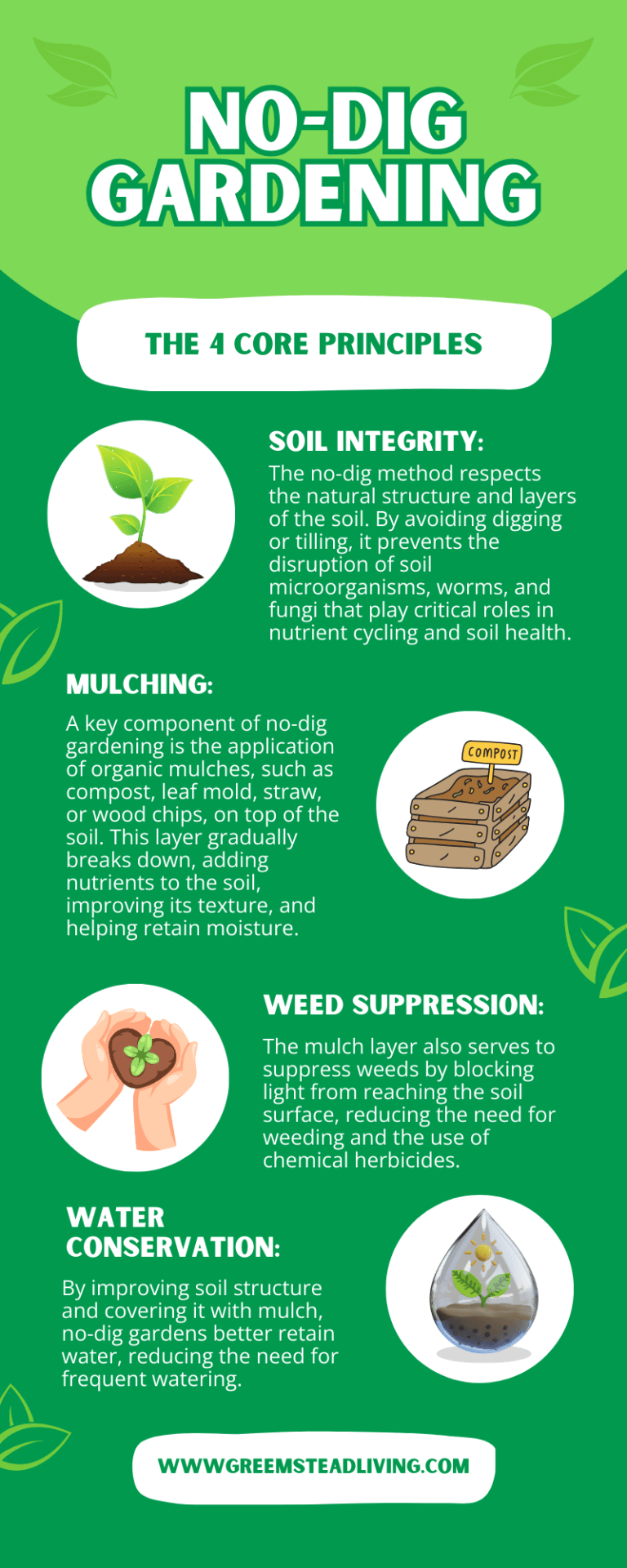
No-dig gardening is increasing in popularity because of its accessibility (it’s a great way for beginners to get stuck into gardening quickly) as well as its results in producing excellent-tasting vegetables with not too much effort. Below are some of the key benefits you can expect from your no-dig garden.
The quality of your soil governs its success in so many ways.
While it may just look like a pile of dirt, soil is home to millions of organisms that are vital for many characteristics of your plants, from taste to size. Over 25% of all known organisms on the planet live underground, from bacteria and fungi to insects and small mammals, all of which play crucial roles in boosting soil health.
Disturbing the soil, whether by tilling, turning, or worse, using weed killers, inevitably harms and kills these vast underground ecosystems, depriving your soil of vital nutrients. Digging also harms the mycelium, a vital fungal network beneath the ground that aids in the growth and intercommunication of plants and trees on a wider scale.
The benefits even extend to human health. This study found a relationship between soil health and human gut microbiome health, a factor known to affect the brain through the gut-microbiome axis.
The study proposes viewing both the soil/root microbiome and the human intestinal microbiome as interconnected “superorganisms” that can benefit from mutual interaction.
This perspective encourages a reevaluation of our lifestyle, dietary habits, and agricultural practices to enhance both human and environmental health, promoting a symbiotic relationship between soil microbiomes and the human gut microbiome for overall well-being.
No-dig beds utilize layers of cardboard – abundant and biodegradable – to form the foundation of your beds, with compost and plants placed above. This raises your beds slightly off the ground, meaning less bending over for those who struggle with mobility.
The cardboard used as the base of your bed suffocates the weeds of sunlight, killing them outright. The traditional way of pulling weeds leaves traces of roots in the system that will continue to grow when in the presence of light, resulting in a never-ending battle.
As a result, no-dig gardening will significantly reduce the number of weeds you will have to deal with. You will still get the occasional weed, but they are easy to remove with a trowel and can be thrown in your compost pile.
Alongside the cardboard base, no-dig gardening makes use of composting to keep your beds thriving on their own with minimal intervention. Compost is excellent at retaining moisture, keeping your soil hydrated, and reducing time spent watering.
Since your compost is only lightly compacted, you will find pulling your plants effortless; even deep-rooted vegetables such as potatoes will come up far easier than they would when rooted underground, further minimizing damage to the soil.
A common misconception is that no-dig beds yield less than traditional till methods. Fortunately, no-dig gardeners like Charles Dowding have shown this is not the case.
The high soil-organism content means the soil is incredibly nutrient-rich, and this doesn’t get disturbed by constant digging.
Using compost also helps to retain nutrients and moisture, creating a healthier environment for plants to grow.
As a result, no-dig gardeners have reported better-tasting plants and higher yields with much less maintenance and work.
Charles Dowding himself reports that he can yield around 4 kg of vegetables per square meter, encompassing 22 different vegetable species, at the very top of the 1-4 kg per square meter range for conventional gardening methods.
Since no-dig gardening takes a more hands-off approach, it’s the perfect way for beginner gardeners to enter the fascinating world of plant growing.
Beyond a trail and a water hose for occasional watering and weeding, you don’t need any tools that you would if you were to break ground.
It is also an inexpensive way to garden. The largest investment is the upfront cost of compost. But at around $10 a bag, and cheaper when buying by the cubic yard, it is a small cost that yields excellent results. You only need to purchase compost once, as the soil health should take care of itself season after season, especially when topped up periodically with your own homemade compost.
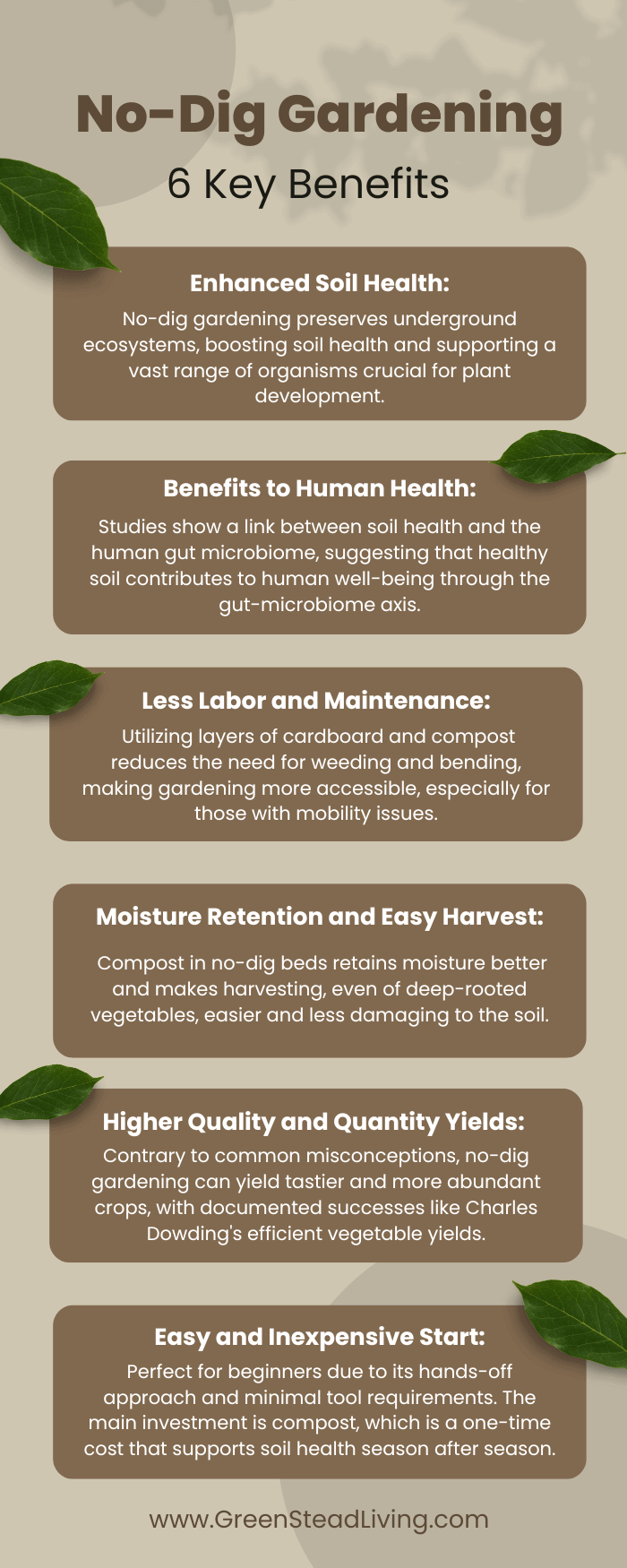
Knowing where to start with your no-dig garden can seem overwhelming, so follow these five simple steps to embrace this magnificent way of life.
Finding the perfect spot in your garden for a no-dig bed involves considering several factors to ensure your garden thrives.
The first consideration is sunlight exposure. Plants need sunlight to grow, but the amount required can vary significantly between species. Most vegetables and flowers thrive in full sun and typically require 6 to 8 hours of direct sunlight per day.
Given the constraints of your garden’s location, it’s important to select a good spot that will facilitate plant growth. It may not be perfect, but all we can do is pick the best spot available and pick plants that are best suited for it. For plots where there is minimal sunlight, choose plants and vegetables that are better suited to more shady locations.
High winds can damage plants and dry out soil, particularly in the colder months. If your area is prone to strong winds, choose a spot that is somewhat protected by natural landforms or buildings, or consider installing a windbreak like a hedge or fence near your garden. Windbreak netting can also be used to mitigate the effects of wind.
Fortunately, you don’t have to worry about areas with weeds or bad soil; we will utilize cardboard to kill the weeds, and since we are building raised beds out of compost, the ground soil conditions do not matter too much.
Don’t succumb to analysis paralysis here – simply pick the best spot you can with the knowledge you have and make a start. Start small and build out as your competence and confidence grows.
While it may seem unconventional, layering cardboard as the base of your beds is the backbone of the work that facilitates excellent plant growth.
Simply place sheets of brown and unglazed cardboard onto the weeds or grass, building up three or four layers and overlapping them well. The intent is to completely deprive the weeds of all sunlight to stop them from germinating, so you must cover the ground well without any gaps or breaks. Even the notoriously difficult-to-kill bindweed will eventually give up without light.
If you don’t have weeds and your soil is mostly clean, you don’t need to use cardboard, but I recommend it for most gardens as a barrier to potential future weeds lurking dormant.
For those really weedy areas, such as abandoned allotments with waist-high brambles, get a head start on killing these weeds by using a thick black tarp. It may take a while, but without sunlight, these weeds will soon wither to nothing.
Don’t worry about borders for your raised beds. You can add wooden borders if you don’t like the appeal of the cardboard edges, just make sure they are not rotten, and replace them when they start to rot to avoid the scourge of slugs.
A common question is how the roots of the plants will grow if there is cardboard blocking the bottom of the bed. The cardboard is simply a temporary barrier to kill the roots and will decompose after 8-10 weeks, long enough to suffocate the weeds while short enough to decompose before the roots breach it, making cardboard such a wonderful material for no-dig planting.
Depending on the size of your plot, you may need a lot of cardboard. Fortunately, this can almost always be found for free; many shops will have a lot of excess cardboard that they struggle to get rid of, and will gladly give you more than you ever possibly need.
Just make sure it’s plain brown cardboard, not shiny or printed cardboard, which will leach chemicals and ink into your soil – exactly what we are trying to avoid.
Once your cardboard is placed, it’s time to add your compost.
Aim for four inches of store-bought compost. You can use your own if you like, but it’s hard to get a significant amount of homegrown compost, and the organic store-bought stuff has lots of goodness already packed into it.
The compost will form your plant bed, feeding both the plants and the myriad of organisms living among them. Worms and insects will facilitate further microbial growth, providing a steady stream of nutrients and moisture.
Slightly firm the soil with your feet, taking care not to compact your compost too much. While it needs some firmness for the roots to take hold and to hold the moisture, compacting too much will make it harder for the roots to propagate.
This should be the only time you need to import compost into your garden. A simple top-up of homegrown compost once or twice a year will be all you need to keep your soil health in prime condition.
Once your bed is in place, and has been lightly compacted to provide just enough structural integrity, it’s time to plant your crops.
Start with easier plants in your first year, then experiment with some more complex ones as you learn and grow. Radishes, potatoes, beans, and peas are excellent starting plants that will thrive in your nutrient-rich compost. Consider this guide on companion planting for vegetables to select plants that will work alongside each other.
While you can start with seeds, I recommend growing or purchasing some seedlings, ideally propagated seedlings that have been grown from seeds that were deliberately planted and nurtured in a controlled environment, such as a greenhouse or nursery, until they reach a certain stage of development.
For larger seeds, such as sprouting potatoes, place them in the compost and create a mound over the top, which will stick out slightly above the rest of the bed.
When picking your plants, leave the roots of the vegetables in the ground so the extra organic matter can continue to nourish the soil.
Fortunately, no-dig gardening means you won’t be doing too much maintenance.
Despite our best efforts to place the cardboard to kill the weeds, some determined weeds will still find their way through any small degrading areas. Grab a small trowel and try to get as much of the root as you can, without disturbing the soil too much. You won’t get the parent root, but you will continue to weaken the whole weed system, ensuring it stays suppressed.
How often you water your plants depends on many factors, as with any other method of gardening, including the climate, season, weather patterns, type of plants you’re growing, and the soil’s ability to retain moisture.
Remain vigilant for signs of over- and under-watering. When under-watered, plants look wilted or droopy, especially during the hottest part of the day, and the soil will be dry an inch below the surface. Over-watered plants show yellow or brown leaves that may fall off, or they will look overly soft and bloated with soggy-feeling soil.
Most no-dig gardens benefit by topping up with compost at least once a year, usually done in early spring, before the planting season begins, to prepare the beds and provide nutrients for the upcoming growing season. Just an inch or two is needed here, taking care not to create too thick of a barrier for seedlings to appear.
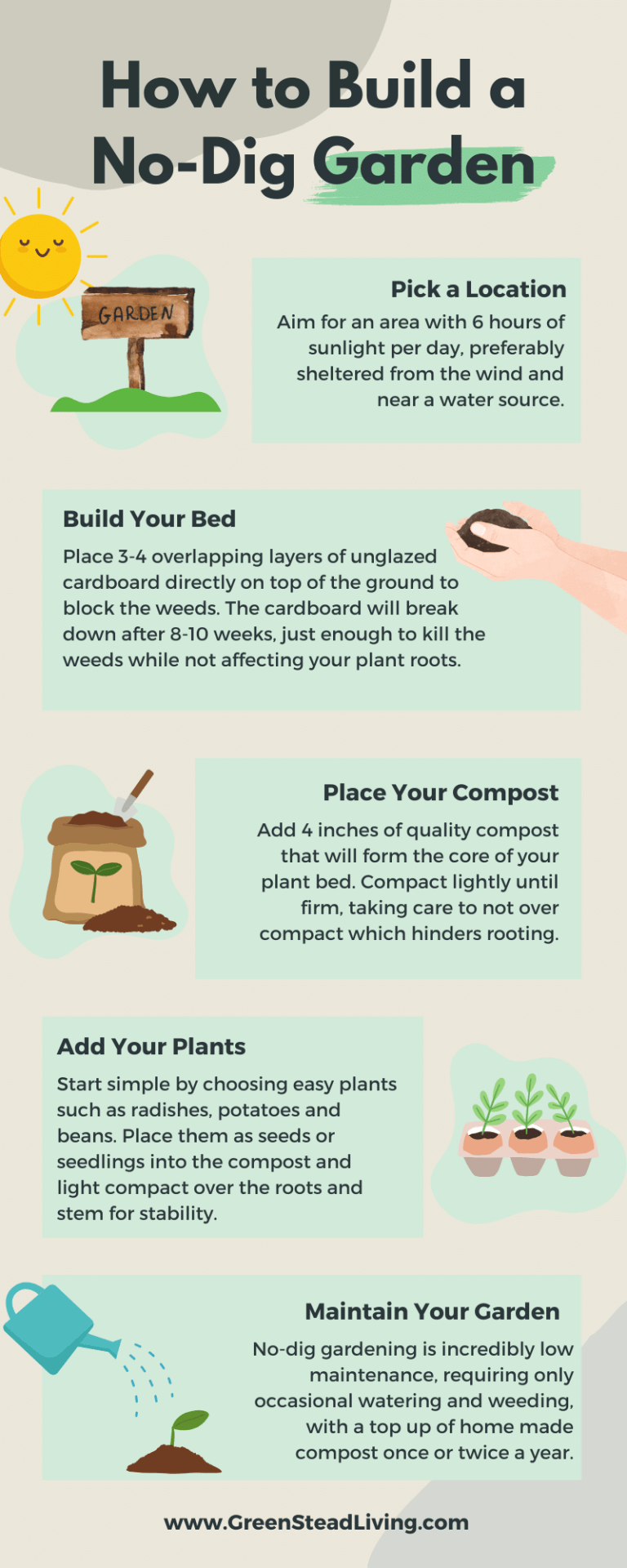
No-dig gardening stands as a testament to the beauty and efficiency of working in harmony with nature, offering a refreshing perspective on how we approach the art and science of gardening.
This sustainable and accessible method champions the principles of minimal soil disturbance, emphasizing the preservation of the delicate, yet vitally important, soil ecosystem.
One of the most innovative aspects of no-dig gardening is its use of compost as a surface mulch, not only feeding the soil from above, mirroring the natural process of organic matter accumulation on the forest floor, but also inviting a bustling world of worms and insects.
The benefits of adopting a no-dig approach extend beyond the soil; gardeners enjoy lush yields and robust plants with significantly less maintenance and weeding compared to conventional methods.
By embracing no-dig gardening, you’re not just planting seeds for the season; you’re sowing the future of sustainable living, one garden at a time.
no-dig gardening is a low-maintenance and sustainable method of gardening that focuses on minimizing soil disturbance, thereby promoting a microbe-rich soil that benefits growing plants.
While it may seem unconventional, layering cardboard as the base of your beds is the backbone of the work that facilitates excellent plant growth.
Simply place sheets of brown and unglazed cardboard onto the weeds or grass, building up three or four layers and overlapping them well. The intent is to completely deprive the weeds of all sunlight to stop them from germinating, so you must cover the ground well without any gaps or breaks. Even the notoriously difficult-to-kill bindweed will eventually give up without light.
The core focus behind no-dig gardening is enhancing the soil quality, specifically the preservation of microbes and organisms that work out of sight in your soil, all of which are impacted by breaking the soil when tilling, turning, or using chemicals.

Learn how to preserve eggs for long term use, using the age-old technique of water glassing.

Learn about the benefits of beef tallow for skin, from its complement of skin enriching vitamins to its complete fatty acid profile.
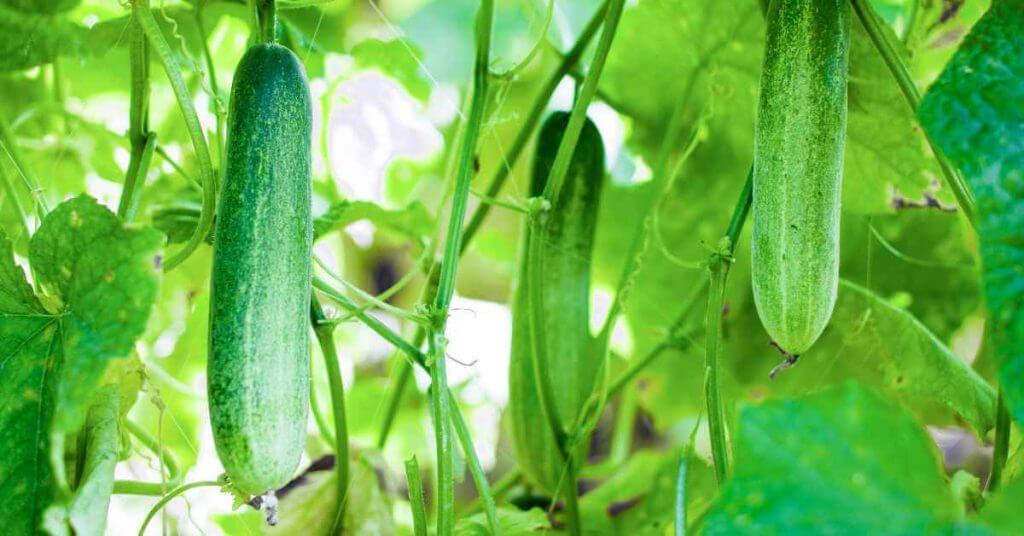
Here is a list of the 5 best companion plants for cucumbers that will help your cucumbers, and your garden as a whole, thrive.

An easy beginners guide on how to make compost, the right way, for a healthier garden.

Reverse osmosis water filtration systems offer the best way to obtain clean and healthy tap water for drinking.
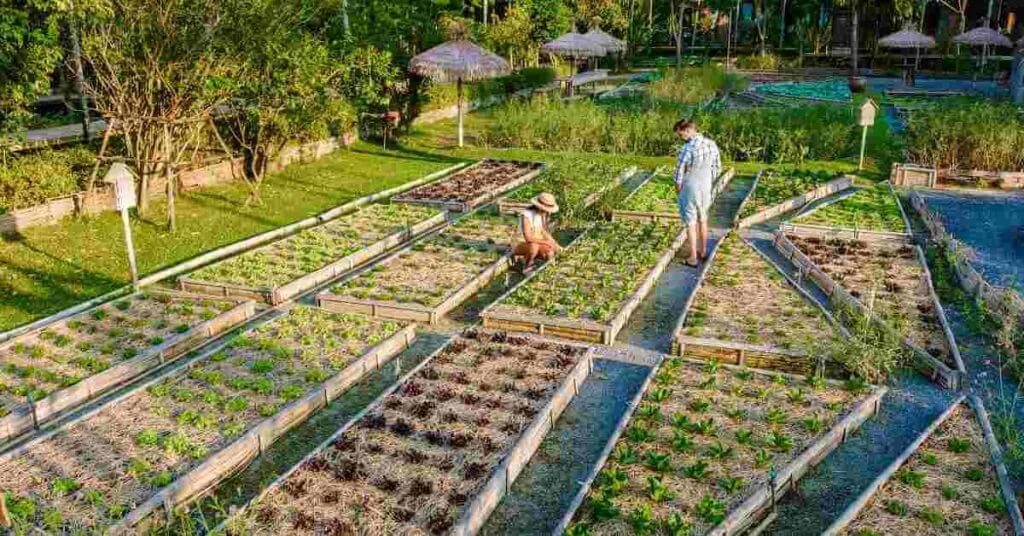
Raised beds are an excellent way of gardening for healthy and plentiful fruits and vegetables. Here are the benefits and which type of raised bed might work best for you.